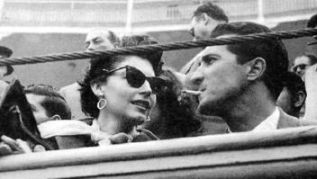Luis Miguel González Lucas (Dominguín) Spain's famous bullfighter died May 8, 1996..
Luis Miguel González Lucas (November 9, 1926, Madrid - May 8, 1996) was a famous bullfighter from Spain, better known as Luis Miguel Dominguín. His father was the legendary Domingo Dominguín; he adopted his father's name to gain popularity.
Dominguín enjoyed wide popularity during the 1940s and 1950s, becoming a legend on his own as he conquered bulls all over Spain, Portugal, Colombia and other places. He debuted at the age of eleven and was active in the card where another legend, Manolete, lost his life.
Dominguín was also a socialite having friends like Pablo Picasso and who had a tempestuous romance with the American actress Ava Gardner and the fashion model China Machado.
Dominguín enjoyed wide popularity during the 1940s and 1950s, becoming a legend on his own as he conquered bulls all over Spain, Portugal, Colombia and other places. He debuted at the age of eleven and was active in the card where another legend, Manolete, lost his life.
Dominguín was also a socialite having friends like Pablo Picasso and who had a tempestuous romance with the American actress Ava Gardner and the fashion model China Machado.
Luis Miguel Dominguín and American actress Ava Gardner
In 1954, he married actress Lucia Bosé. In 1959, he and his brother-in-law, Antonio Ordóñez, engaged in a bullfighting rivalry that was chronicled by Ernest Hemingway in his book, The Dangerous Summer. Ordóñez won.


No comments:
Post a Comment